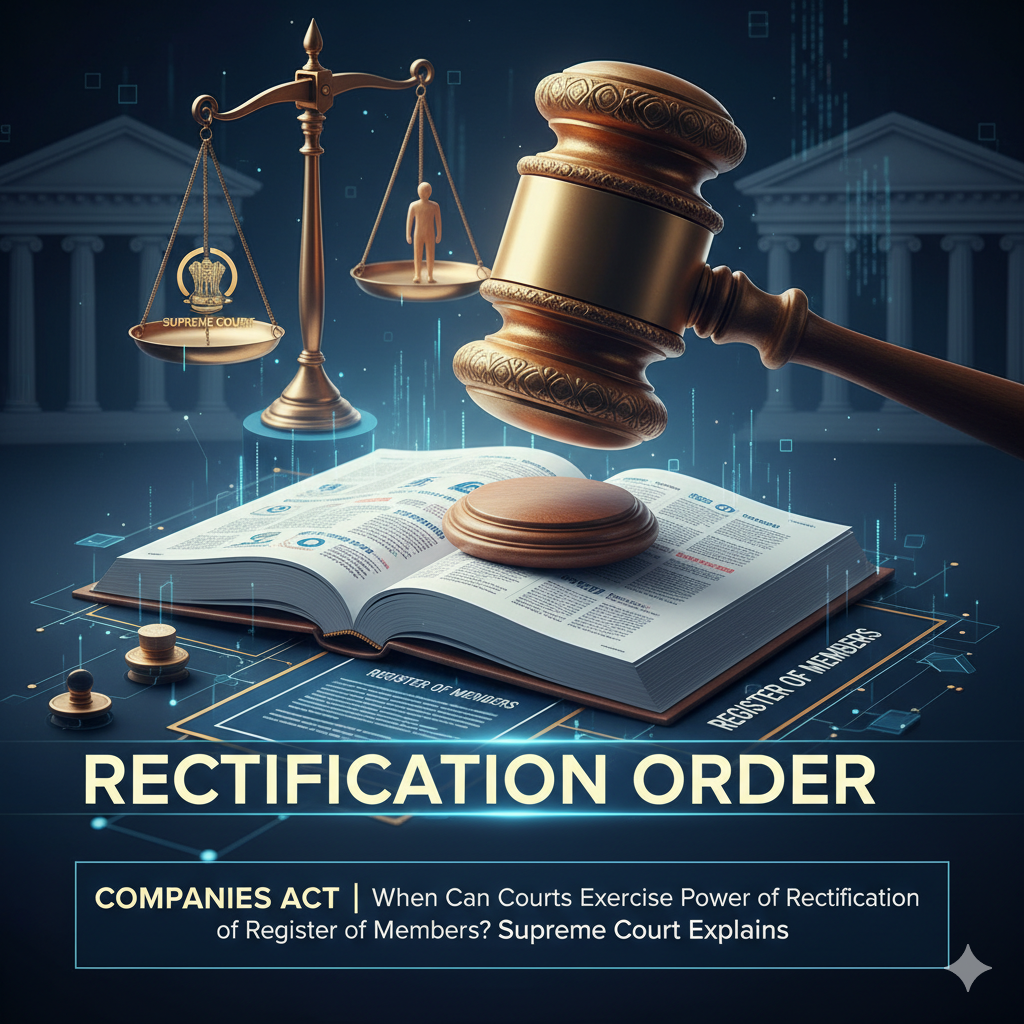View News
When Can Courts Exercise Power of Rectification of Register of Members

Companies Act | When Can Courts Exercise Power of Rectification of Register of Members? Supreme Court Explains
Introduction
The rectification of the register of members is one of the most crucial remedies available under the Companies Act, 2013 for shareholders who allege fraud, wrongful removal, or illegal transfer of shares. Although Sections 59 and 430 of the Act confer jurisdiction on the National Company Law Tribunal (NCLT) to adjudicate disputes relating to rectification, Indian courts have consistently insisted that this remedy is discretionary and must be exercised with caution.
In a recent and significant ruling, the Supreme Court of India, per the Bench of Justices Sanjiv Khanna and Sanjay Kumar, clarified the contours of this jurisdiction and laid down guiding principles for when courts and tribunals may step in to correct the register of members. The Court emphasized that rectification powers may be invoked particularly in cases where the applicant is a victim of an “open-and-shut case of fraud” committed by the opposing parties.
This judgment brings much-needed clarity on what constitutes “rectification” and the circumstances in which the NCLT can intervene, especially in the context of shareholding disputes that frequently arise in family-run companies and closely held corporate structures.
Key Principles Laid Down by the Supreme Court
The Supreme Court’s decision elaborates three central themes:
1. Meaning and Scope of “Rectification”
The Court reiterated that rectification refers to a correction made to the register of members to ensure that the register accurately reflects the company’s ownership structure. This correction may include:
-
Restoring a name that has been wrongfully omitted or removed
-
Deleting a name that was included through fraudulent or illegal means
-
Correcting the number of shares allotted or transferred
-
Updating ownership details to reflect genuine transactions
However, the Court emphasized that rectification is not meant to substitute full-fledged civil adjudication in highly disputed matters. Thus, while tribunals can decide issues directly connected to share transfers, they should refrain from entertaining matters involving:
-
Complex evidence
-
Contractual disputes
-
Allegations requiring extensive trial
-
Matters better suited to civil courts
2. Rectification Jurisdiction Appropriate in “Open-and-Shut” Fraud Cases
A major highlight of the judgment is the recognition that NCLT/NCLAT can intervene when fraud is so evident that further detailed trial is unnecessary.
The Court described such situations as:
-
Clear-cut fraudulent removal or addition of a shareholder
-
Manipulation of share transfer forms
-
Forged signatures
-
Issuance of shares without consideration or without proper authorization
-
Tampering with ROC filings
-
Allotment of shares with an intention to dilute the holdings of an existing shareholder
Where documentary evidence overwhelmingly supports the claim and the fraudulent act is prima facie obvious, the Tribunal is empowered—and even obligated—to rectify the register.
The rationale is to prevent wrongdoers from benefiting from procedural delays or forcing the victim into avoidable litigation.
3. Company Courts Must Exercise Caution and Apply Limited Jurisdiction
The Supreme Court stressed that although the rectification remedy is powerful, it must be used sparingly. Tribunals must determine at the preliminary stage whether:
The dispute is purely about the validity of a transfer or allotment,
or
It is a deeply contentious issue requiring full civil trial.
Accordingly:
-
If the case involves contested agreements, oral understandings, complex legal instruments, or contradictory evidence, the matter should go to a civil court.
-
If the dispute concerns forgery, fraud evident from records, or procedural violations, the NCLT can order rectification.
Thus, the nature of the dispute determines jurisdiction, not merely the fact that shares are in question.
Why This Judgment Matters
1. Clarifies the boundaries of NCLT’s jurisdiction
The decision strikes a balance between the NCLT's role as a corporate dispute forum and the civil courts’ jurisdiction over contractual and complex factual matters.
2. Protects shareholders from wrongful dilution
Victimized shareholders now have clearer judicial support for approaching the NCLT directly when documentary evidence reveals wrongdoing.
3. Encourages corporate discipline
Companies must ensure:
-
Share transfer procedures are fully compliant
-
ROC filings accurately reflect ownership
-
Internal records are tamper-proof
-
Allotments are transparent and authorized
4. Reduces frivolous litigation
Parties cannot misuse the rectification provision to cloak ordinary contractual disputes in the garb of a corporate remedy.
Conclusion
The Supreme Court’s judgment provides long-awaited clarity on the circumstances under which rectification of the register of members can be ordered under the Companies Act, 2013. By distinguishing simple cases of fraud from complex disputes, the Court ensures that genuine victims of illegal share transfers receive swift justice, while also preventing misuse of the rectification remedy to bypass civil courts.
The ruling reinforces that the NCLT is a specialized body with the power to address corporate wrongs—but one that must exercise its jurisdiction prudently, cautiously, and only within the framework intended by the legislature.
Unlock the Potential of Legal Expertise with LegalMantra.net - Your Trusted Legal Consultancy Partner”
Disclaimer: Every effort has been made to avoid errors or omissions in this material in spite of this, errors may creep in. Any mistake, error or discrepancy noted may be brought to our notice which shall be taken care of in the next edition In no event the author shall be liable for any direct indirect, special or incidental damage resulting from or arising out of or in connection with the use of this information Many sources have been considered including Newspapers, Journals, Bare Acts, Case Materials , Charted Secretary, Research Papers etc
LegalMantra.net Team
Anshul Goel

